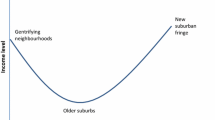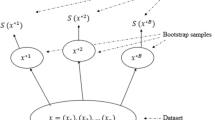Abstract
Segregation is a central concept in the debate on urban issues, both in scientific literature and in society in general. The process of globalisation is particularly expected to increase polarisation and segregation in cities, resulting in the emergence of ‘ghettos’ or – as they are called in the Netherlands – ‘income neighbourhoods’. This paper tries to judge the situation in Dutch cities by studying changes over time; by looking at segregation within cities as well as between cities and the wider metropolitan area; and by comparing socio-economic differences with socio-cultural and socio-demographic characteristics. The analysis shows that the empirical facts are quite different from the ongoing debate. It establishes that socio-economic segregation is more moderate than segregation with respect to the other two dimensions. Contrary to suggestions from the vernacular debate, segregation within cities is scarcely increasing, but between cities and the surrounding area it is rising with respect to all three dimensions.
Similar content being viewed by others
References
Abramson A.J., Tobin, M.S. & VanderGoot, M.R., 1995: The changing geography of metropolitan opportunity: the segregation of the poor in U.S. metropolitan areas, 1970-1990. Housing Policy Debate, 6, 45-72.
Brink M. & Pasariboe M. 1993: Asylum seekers in the Netherlands. Amsterdam: University of Amsterdam.
Castells M. & Mollenkopf J. 1991: Dual City: Restructuring New York. Russel Sage Foundation, New York.
Engelsdorp Gastelaars R. van & Vijgen J, 1991: Stadsbuurten en woonkernen in de jaren negentig; hun veranderende betekenis als lokaal woonmilieu. In: Kempen R. van, Musterd S. & Ostendorf W. (eds), Maatschappelijke verandering en stedelijke dynamiek. Volkshuisvesting in theorie en praktijk No. 30. Delftse Universitaire Pers, pp. 107-119.
Esping-Andersen G., 1990: The three worlds of welfare capitalism. Cambridge: Polity Press, Cambridge.
Fainstein S.S., Gordon I. & Harloe M. (eds.), 1992: Divided cities: New York and London in the contemporary world. Basil Blackwell, Oxford.
Hamnett Chr., 1993: Social polarisation in global cities: theory and evidence. Urban Studies, 31, 401-424.
Massey D.S. & Denton N.A., 1993: American Apartheid. Harvard University Press, Cambridge.
Murdie R.A., 1994: 'Blacks in near-ghettoes?’ Black visible minority population in metropolitan Toronto housing authority public housing units. Housing Studies, 9, 435-457.
Musterd S., 1994: A rising European underclass? Social polarisation and spatial segregation in European cities. Built Environment, 20, 185-191.
Musterd S., Ostendorf W. & Breebaart M., 1998: Multi-Ethnic Metropolis: Patterns and Policies. Kluwer Academic Publishers, Dordrecht, Holland.
Musterd S. & Ostendorf W. (eds), 1998: Urban Segregation and the Welfare State.; Inequality and exclusion in western cities. Routledge, London.
O'Loughlin J. & Friedrichs J. (eds.), 1996: Social Polarisation in Post-Industrial Metropolises. Walter de Gruyter, Berlin.
Pahl R., 1984: Divisions of Labour. Basil Blackwell, Oxford.
Peach C. & Byron M., 1993: Carribean Tenants in Council Housing: ‘Race’, Class and Gender. New Commun. 19, 407-423.
Sassen-Koob S., 1986: The new labor demand in global cities. In: Smith M.P. (ed.), Cities in Transformation: Class, Capital and the State. Sage, Beverly Hills, pp. 139-171.
Sassen S., 1991: The Global City: New York, London, Tokyo. Princeton University Press, Princeton.
SCP, 1996: Sociaal en Cultureel Rapport 1996. Sociaal en Cultureel Planbureau, Rijswijk.
Shevky E. & Bell W., 1955: Social Area Analysis. Stanford University Press, Stanford.
Soja E.W., 1991: The Stimulus of a Little Confusion; A Contemporary Comparison of Amsterdam and Los Angeles. AME, Amsterdam.
Wilson W.J., 1987 The Truly Disadvantaged, the Inner-City, the Underclass and Public Policy. University of Chicago Press, Chicago.
Author information
Authors and Affiliations
Rights and permissions
About this article
Cite this article
Musterd, S., Ostendorf, W. The changing distribution of incomes in Dutch cities: myth and reality. GeoJournal 46, 29–38 (1998). https://doi.org/10.1023/A:1006920422743
Issue Date:
DOI: https://doi.org/10.1023/A:1006920422743




